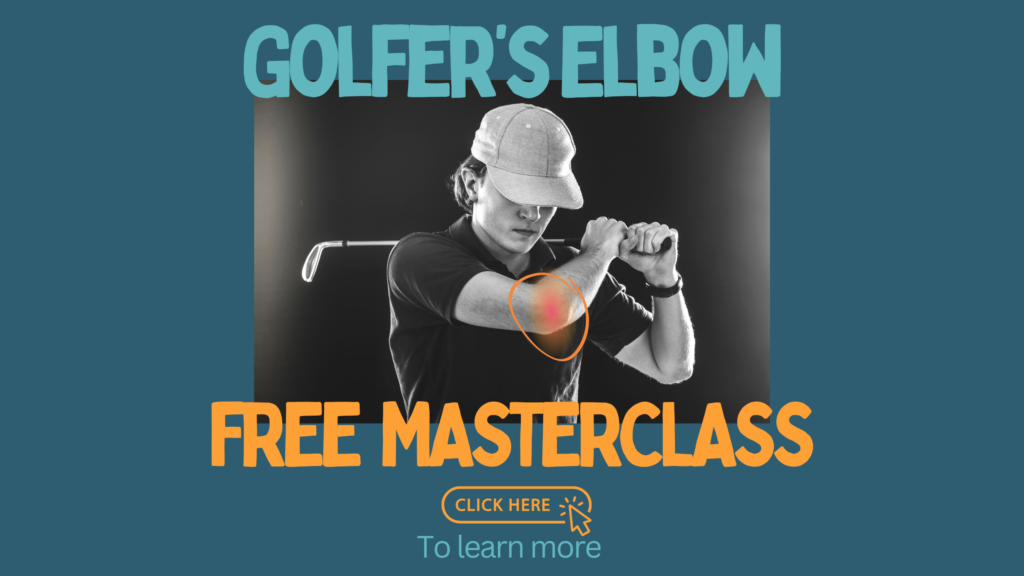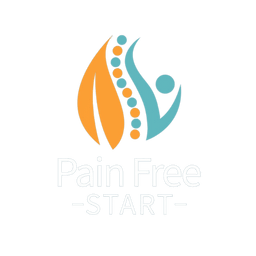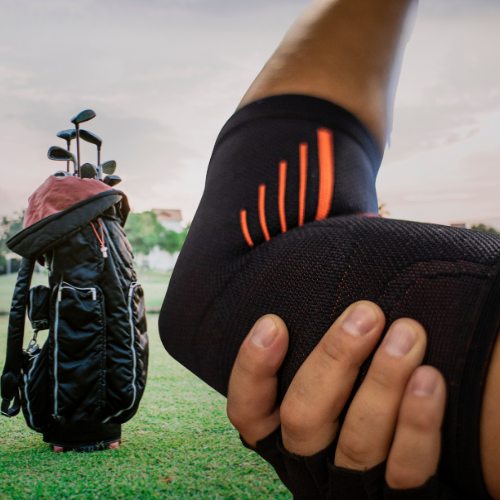Introduction
Golfer’s elbow, or medial epicondylitis, is a common condition that causes pain and inflammation on the inner side of the elbow. As a physiotherapist, I know how hard it is to resolve this difficult problem and ensure it doesn’t return. But whilst you are completing your rehab some extra support may help you manage your symptoms. However, this is not an alternative to doing the work and improving the health of your tendon. In this comprehensive guide, I’ll discuss the best options for elbow supports, elbow straps, and general braces, how they work, and what to look for when choosing one.
Understanding Golfer’s Elbow
Golfer’s elbow is characterised by pain and tenderness on the inside of the elbow, often caused by overuse or repetitive stress on the tendons that attach to the medial epicondyle. This condition can affect not just golfers but also those who engage in activities involving repetitive wrist and arm motions, such as tennis, weightlifting, and even manual labour. Learn more about Golfer’s Elbow here.
How Elbow Supports and Straps Help
Elbow supports and straps work by applying pressure to the forearm muscles, which helps reduce and redirect strain on the tendons. This can alleviate pain, improve function, and prevent further injury. They come in various designs, including sleeves, straps, and combination braces, each offering unique benefits. I have never had experience of using a supports with patients but it seems that people get relief from them, I have had patients that have found straps useful.
How to Use Elbow Supports and Straps
- Positioning: Place the strap or brace about 2-3 inches below the elbow joint on the forearm.
- Tightness: Adjust the strap so it applies pressure without cutting off circulation. It should feel snug but not uncomfortable. Play around with the position it can take a few readjustments.
- Duration: Wear the support during activities that aggravate your golfer’s elbow. Remove it during rest periods to allow your skin to breathe.
- Combination with Therapy: Use the strap in conjunction with physiotherapy exercises and other treatments for the best results.

How to Become Pain-Free and Not Become a Strap Slave.
In all honesty, when I see people in clinic I don’t immediately recommend straps and so far I have never recommended the use of a support. The problem is they just temporarily cover up the fact that you have an unhealthy and overused tendon – which needs treating. So instead I give people the tools they need to fix their Golfers Elbow. With the right treatment program, you could be pain-free in a couple of weeks – meaning no need for a strap at all.
Case Study – Ian’s Story
Ian is an avid golfer who I had been treating for back pain, he mentioned he struggled with Golfers elbow and having tried unsuccessfully a few stretches and exercises he assumed he would always have it. He had been using an elbow strap for about 6 months, it reduced his pain a little when playing but never resolved it. Ian followed my advice and exercise program and quickly became pain-free, he now has no pain and no need for an elbow strap. He is loving life and loving golf now he has a pain-free elbow and back. If you would like to know more about the program Ian followed click here.
Additional Tips for Managing Golfer’s Elbow
- Relative Rest and Ice: Avoid aggravating activities such as gripping, flexing the wrist and twisting the forearm. Apply ice to reduce inflammation and pain.
- Strengthening Exercises: Engage in strengthening exercises for the forearm and wrist muscles to improve the health of the tendon and prevent future injuries. WARNING – remember this is an overuse injury so it is important to get the balance between too much and too little right to avoid making things worse.
- Proper Technique: Ensure you use proper technique in activities that involve repetitive arm motions to reduce strain on the tendons. Don’t over-grip! often we grip harder than is needed overloading muscles more.
- Stretching: Incorporate gentle stretches for the forearm muscles to improve flexibility and reduce tension. WARNING – overstretching or stretching too early on can aggravate the tendon. Take a look at this blog for some simple elbow stretches.
Top Elbow Supports for Golfer’s Elbow
Here are some of the best elbow supports that others have found useful:
Simien Elbow Brace
- Design: Forearm strap with an adjustable compression pad.
- Features: Lightweight, breathable material with a hook-and-loop closure for a customisable fit.
- Why It’s Great: The Simien Elbow Brace is simple yet effective, providing targeted relief from pain and discomfort through precise pressure application.
McDavid 489 Elbow Strap
- Design: Single strap with a pressure pad.
- Features: Neoprene material for compression and heat retention, adjustable strap for a secure fit.
- Why It’s Great: The McDavid 489 offers excellent support and comfort. The neoprene material helps retain heat, promoting blood flow and healing.
Copper Compression Recovery Elbow Sleeve
- Design: Full elbow sleeve with copper-infused fabric.
- Features: Provides compression, supports the entire elbow joint, and contains copper for anti-inflammatory benefits.
- Why It’s Great: This sleeve not only supports the tendons but also provides overall elbow joint stability. The copper-infused fabric may help reduce inflammation and accelerate recovery.
Kunto Fitness Elbow Brace
- Design: Elbow sleeve with a four-way stretch fabric.
- Features: Breathable, moisture-wicking material, snug fit without restricting movement.
- Why It’s Great: The Kunto Fitness Elbow Brace offers excellent compression and support while maintaining flexibility, making it ideal for active individuals.
Vive Elbow Brace
- Design: Combination of forearm strap and full elbow sleeve.
- Features: Adjustable strap for targeted compression, lightweight and breathable fabric.
- Why It’s Great: The Vive Elbow Brace combines the benefits of a forearm strap and a sleeve, providing comprehensive support and relief.
Top Elbow Strap for Golfers’ Elbow
- Elbow straps specifically target the forearm muscles and are effective for reducing strain on the tendons, here are a few that are highly rated:
TOMUST Elbow Brace
- Design: Dual strap system with a compression pad.
- Features: Adjustable straps, neoprene and nylon construction for comfort and durability.
- Why It’s Great: The dual strap system allows for more precise pressure application, ensuring optimal relief and support during activities.
BandIT Therapeutic Forearm Band
- Design: Unique hook-and-loop design for targeted pressure.
- Features: Adjustable strap and ergonomic shape for comfort.
- Why It’s Great: This band offers targeted pressure exactly where it’s needed, making it a favourite among those with golfer’s elbow.
Pro Band Sports BandIT Elbow Brace
- Design: Band with two plastic plates and a hook-and-loop strap.
- Features: Adjustable, breathable, and lightweight.
- Why It’s Great: The Pro Band Sports BandIT provides focused pressure on the forearm muscles, reducing strain on the tendons.
Not Sure If You Have Golfers Elbow?
Join me on this FREE Masterclass, together we assess your elbow to find out if you have golfers elbow. Before learning more about this annoying problem and how to treat it. Click here to learn more about the masterclass and enrol. Hope to see you there.

Conclusion
Managing golfer’s elbow can be challenging, but the right elbow strap can provide significant relief and support during your recovery. The straps mentioned above offer a combination of comfort, support, and effectiveness. Remember, while a strap can help manage symptoms, it’s important to address the root cause through proper exercise, technique adjustments, and physiotherapy. You are now armed with all the information you need to resolve this tricky problem, once and for all. If you experience persistent pain or are unsure which strap is right for you, consult with a physiotherapist for personalised advice. By taking proactive steps and using the right tools, you can get back to enjoying your favourite activities pain-free.
Take care, Helen
Helen Manders BSc (Hons) MCSP HCPC
Chartered Physiotherapist Treating Golfers Elbow Since 2001



